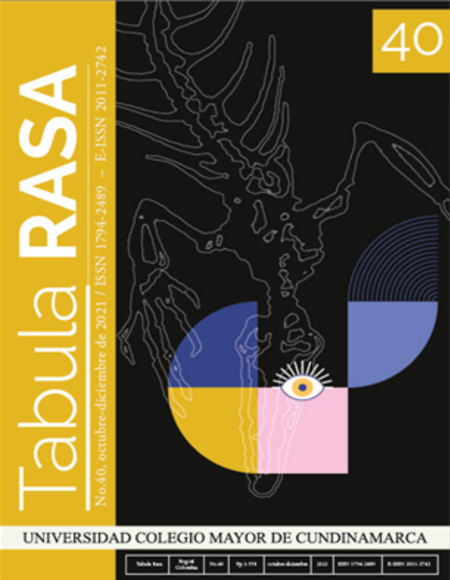Dog Entanglements: Big Game Hounds in Uruguay from the View of Varied Social Collectives
Enredos perrunos: el perro de caza mayor en Uruguay desde diferentes colectivos sociales
Show authors biography
Dogs are critical elements in the practice of various modalities of big game. They are primarily used in wild boar hunting, in which dogs often are dead or injured. In this line of thought, some social collectives are against using hounds in hunting, arguing it entails a high risk for dog welfare or its severe impact on native species conservation efforts. This work focuses on the significance of big game hounds among various social collectives in Uruguay. We analyze the meanings of dogs in this social scheme and the strains between hunters, animal rights collectives, and the State. We suggest big game hounds resulted from an entanglement of practices and representations related to game, animal rights, and nature conservation.
Article visits 193 | PDF visits 169
Downloads
Arluke A. (2006). Just a dog: understanding animal cruelty and ourselves. Philadelphia: Temple University Press.
Blaser M. (2019). Reflexiones sobre la ontología política de los conflictos medioambientales. América Crítica, 3(2), 63-79. https://doi.org/10.13125/americacritica/3991
Blaser, M. (2013) Ontological Conflicts and the Stories of People in Spite of Europe. Current Anthropology, 54(5), 547-568. http://dx.doi.org/10.1086/672270
Blaser M. (2009). La ontología política de un programa de caza sustentable. Revista red de antropologías del mundo, 4, 81-108. http://ram-wan.net/old/documents/05_e_Journal/journal-4/jwan4.pdf
Byrd, E., Lee, J.G. & Widmar, N. (2017). Perceptions of Hunting and Hunters by U.S. Respondents. Animals, 7(11), 83. https://doi.org/10.3390/ani7110083
Calarco, M. (2008). Zoographies: The Question of the Animal froHeidegger to Derrida. New York: Columbia University Press.
Carman, M. (2017). El activismo proteccionista, o las disímiles imputaciones de dignidad a animales y humanos. Etnografías Contemporáneas, 3(4), 128-155. https://ri.conicet.gov.ar/bitstream/handle/11336/76852/CONICET_Digital_Nro.6268c2ed-7350-4adfb85c-3a2aa2de1518_A.pdf?sequence=2&isAllowed=y
Change.org (2018). Prohibir la caza en Uruguay, #stopcazauy. https://www.change.org/p/diputadosuy-tabarevazquez-scpresidenciauy-prohibir-la-caza-en-uruguaystopcazauy?fbclid=IwAR3qcbeWSWSScd3_kTWfEXxynHgWmbl0yta2hCLa54_wJGGd_wefb90bZSk
Cotryba (2020). Comisión Tenencia Responsable y Bienestar Animal. http://www.mgap.gub.uy/unidad-organizativa/comision-de-tenencia-responsable-y-bienestar-animal.
Dabezies, J. (2019). Discursos y tensiones entre caza, conservación y derechos de los animales en Uruguay. Etnobiología, 17(2), 11-24. https://revistaetnobiologia.mx/index.php/etno/article/view/106
De la Cadena, M. (2015). Earth Beings. Ecologies of Practice across Andean Worlds. Durham: Duke University Press.
De la Cadena, M. (2010). Indigenous Cosmopolitics in the Andes.Conceptual Reflections beyond Politics. Cultural Anthropology, 25(2), 334-370. https://www.humanities.uci.edu/critical/pdf/cadena.pdf
Descola, P. (2009). Human Natures. Social Anthropology, 17(2), 145-157.
Descola, P. (1996). La selva oculta. Simbolismo y praxis en la ecología de los achuar. Quito: Abya Yala. Colección Pueblos del Ecuador.
Diegues, A. (2008). O mito moderno da naturaleza intocada. São Paulo: Hucitec.
Escobar, A. (2012). Más allá del tercer mundo. Globalización y diferencia. Bogotá: Icanh–Universidad del Cauca.
Fischer, A., Kereži, V., Arroyo, B., Mateos-Delibes, M., Tadie, D., Lowassa, A. & Skogen, K. (2013). (De)legitimising hunting–Discourses over the morality of hunting in Europe and eastern Africa. Land Use Policy, 32, 261-270. https://doi.org/10.1016/j.landusepol.2012.11.002
Kohn, E. (2017). How Dogs Dream… Diez años después. AIBR: Revista de Antropología Iberoamericana, 12(3), 273-311. https://www.redalyc.org/articulo.oa?id=62354698002
Latour, B. (2008). Reensamblar lo social: una introducción a la teoría del actor-red. Buenos Aires: Manantial.
Libera Asociación Animalista (2020). Facebook. https://www.facebook.com/Stop-CazaUY-479734012444197/
Marvin, G. (2003). A passionate pursuit: foxhunting as performance. The Sociological Review 51, pp. 46-60. https://doi.org/10.1111/j.1467-954X.2004.00450.x
Masjoán J. (2010). Historia del dogo argentino, antigua, moderna y contemporánea, 1930/2009. Buenos Aires: Gráficamente Ediciones.
Medrano, C. (2016). Hacer a un perro. Relaciones entre los Qom del Gran Chaco argentino y sus compañeros animales de caza. Anthropos, 111(3), 113-125.
Milton, K (2002). Loving Nature. Towards an Ecology of Emotion. London: Routledge.
Montero, S. (2019). Encuentros de vida y muerte. Antropología transespecie y mundos ampliados entre cazadores y animales en el suroeste extremeño. (Tesis de grado). Universidad Pablo de Olavide, Sevilla.
Rodríguez R. (2019). Lo animal es político. La Diaria. https://ladiaria.com.uy/opinion/articulo/2019/11/lo-animal-es-politico/
Ruiz Serna, D. & Del Cairo, C. (2016). Los debates del giro ontológico en torno al naturalismo moderno. Revista de Estudios Sociales, 55, 193-204. http://www.scielo.org.co/pdf/res/n55/n55a16.pdf
Singer, P. (1999). Liberación animal. Madrid: Trotta.
Stengers, I. (2005). The cosmopolitical proposal. In B. Latour & P. Weibel (Eds.). Making things public: Atmospheres of democracy (pp.994-1004). Massachussetts: Massachussetts Institute of Technology Press.
Stengers, I. (2000). The Invention of Modern Science. Minneapolis: University of Minnesota Press.
Tola, F. (2007). Eu não estou só(mente) em meu corpo? A pessoa e o corpo entre os Toba (Qom) do Chaco argentino. Mana, 13(2), 499-519. https://doi.org/10.1590/S0104-93132007000200008
Vander Velden, F. F. (2016). Como se faz um cachorro caçador entre os Karitiana (Rondônia). En: Teoria e Cultura, 11(2). https://periodicos.ufjf.br/index.php/TeoriaeCultura/article/view/12281
Viveiros de Castro E. (2019). Perspectival Anthropology and the Method of Controlled Equivocation. Tipití: Journal of the Society for the Anthropology of Lowland South America, 2(1), https://digitalcommons.trinity.edu/tipiti/vol2/iss1/1/?utm_source=digitalcommons.trinity.edu%2Ftipiti%2Fvol2%2Fiss1%2F1&utm_medium=PDF&utm_campaign=PDFCoverPages




